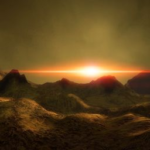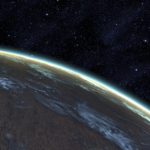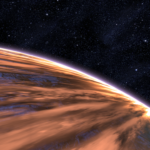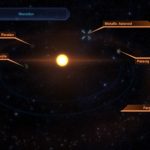System Specs:
- Stellar Mass: 0.296 Sol Masses
- Stellar Class: M3
- Luminosity: 0.01 Sol
- Planets: 4
- Moons: 0
- Asteroid Belts: 1
- Asteroids: 1
- Objects: 0

–
Planets Directory:
- Sharjila
- Porolan
- Patavig
- asteroid belt
- Fargeluse
–
Sharjila:
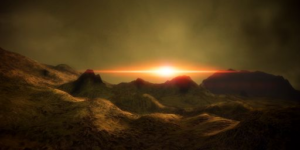
- Orbital Distance: 0.667 AU
- Orbital Period: 1.0 Earth-years
- Keplerian Ratio: 0.297
- Radius: 5,693 km
- Day Length: 40.6 Earth-hours
- Atmospheric Pressure: 39.16 atm
- Surface Temp: 25 °C
- Surface Gravity: 0.9 g
- Mass: 0.712 Earth-masses
WARNING: Level 1 Pressure Hazard
Sharjila has a very dense atmosphere of ammonia and oxygen. Its temperate surface is mainly composed of alumina with deposits of sulfur. Comm buoys in the system have recently logged a number of unregistered vessels operating nearby.
Sharjila has an extensive silicon-based, oxygen-breathing ecology. Heavily populated areas are covered with fine silica (silicon dioxide) dust, the respiratory by-product of the world’s higher animal forms. High-speed surface winds, often laden with abrasive silica dust, present a hazard. In areas where the wind deposits a great deal of silica, footing can be treacherous. EVAs are discouraged.
–
Porolan:

- Orbital Distance: 5.075 AU
- Orbital Period: 21.0 Earth-years
- Keplerian Ratio: 0.296
- Radius: 9,749 km
- Day Length: 45.4 Earth-hours
- Atmospheric Pressure: 1.4 atm
- Surface Temp: −197 °C
- Surface Gravity: 1.5 g
- Mass: 3.479 Earth-masses
Porolan is an enormous terrestrial planet, half again the size of Earth. Despite its thick atmosphere, the weak output of the red dwarf Macedon leaves its surface biting cold. The crust is mainly composed of silica, but significant deposits of iron and other industrial metals are present. These lodes may prove rich enough to be profitably mined despite the heavy gravity.
–
Patavig:
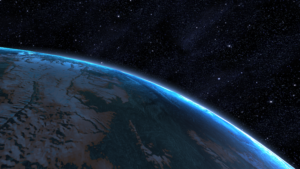
- Orbital Distance: 11.3 AU
- Orbital Period: 69.8 Earth-years
- Keplerian Ratio: 0.296
- Radius: 10,529 km
- Day Length: 30.4 Earth-hours
- Atmospheric Pressure: 22.4 atm
- Surface Temp: −130 °C
- Surface Gravity: 1.6 g
- Mass: 4.328 Earth-masses
Patavig is the second of the Macedon system’s giant terrestrial planets, and by far the more interesting. Most of the surface is covered by a vast sea of liquid ammonia, in which a unique aquatic ammonia-based biosphere has developed. While the frozen continents are largely bereft of life, a rich bounty of complex organisms — many larger than a human — flourish in the chilly, toxic seas.
While dreadfully inhospitable to humans, Patavig is suitable for colonization by the volus. Negotiations between the Systems Alliance and the volus’ patrons, the Turian Hierarchy, have made good progress.
–
Fargeluse:
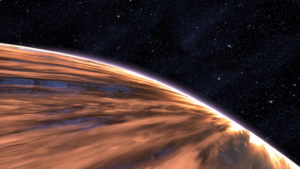
- Orbital Distance: 15.64 AU
- Orbital Period: 111.7 Earth-years
- Keplerian Ratio: 0.296
- Radius: 40,394 km
- Day Length: 19.1 Earth-hours
- Atmospheric Pressure: N/A atm
- Surface Temp: N/A °C
- Surface Gravity: N/A g
- Mass: N/A Earth-masses
Fargeluse is a standard hydrogen-helium gas giant with an abundance of airborne hydrocarbons.
Assignments
Survey: UNC: Valuable Minerals: Gas Deposit ×1 (Xenon)
Properties
Fargeluse is too small to be a “standard hydrogen-helium gas giant” (William Hubbard, The New Solar System 4th ed, 1999; p. 194). It is more likely a dense “ice giant” like Neptune or Gliese 436 b.
–
video

